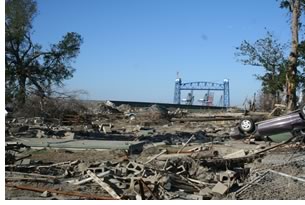

6/2006

by Andrew Goldberg, Assoc. AIA
Manager, Federal Regulatory Activities
 President Bush on June 15 signed into law $19.8 billion to help Louisiana,
Mississippi, Alabama, and other states recovering from Hurricane Katrina
and other storms, including funds for two AIA-supported programs to provide
housing alternatives to mobile trailers and to repair historic structures.
President Bush on June 15 signed into law $19.8 billion to help Louisiana,
Mississippi, Alabama, and other states recovering from Hurricane Katrina
and other storms, including funds for two AIA-supported programs to provide
housing alternatives to mobile trailers and to repair historic structures.
The funds are a part of legislation that provides $94.5 billion for hurricane relief, to fund the war in Iraq, and prepare for a possible flu pandemic.
The law creates a $400 million alternative housing pilot program to be administered by FEMA in Mississippi and Louisiana. These funds are to be used for projects that create modular housing for hurricane victims that is:
- Hurricane resistant
- Available at costs below those of temporary FEMA trailers
- Able to be constructed quickly, using prefabricated panelized walls
- Expandable into larger more comfortable living space as the owners become financially capable of doing so
- Usable as permanent structures.
According to Tom Wolfe, senior director, AIA Federal Affairs, “The AIA lobbied hard for this provision because we believe that innovative programs like this will spur the development of livable transitional and temporary-to-permanent housing and move FEMA away from the large tracts of mobile homes that clearly do not work.” Wolfe commends AIA members who contacted nearly every congressional office in support of the program.
“The pilot program is a great advance to make much-needed housing available to people to begin rebuilding their lives. With the start of the new hurricane season, we must be able to move people quickly into housing that respects the health and safety of our citizens,” says AIA First Vice President RK Stewart, FAIA.
The legislation requires FEMA to prepare a proposal and expenditure plan for approval by the House and Senate Appropriations committees within 45 days of enactment. “The AIA Government Advocacy team is working on comments to FEMA on how these monies can best be used to create new, sustainable, and livable communities,” Wolfe says.
AIA President Kate Schwennsen, FAIA, praises the legislation: “This bill is a tremendous step forward in the recovery process for the Gulf Coast. President-elect RK Stewart, EVP/CEO Chris McEntee, and I had the opportunity to tour affected communities on the coast and in New Orleans with our state and local components. It is true: All the news coverage we have seen fails to prepare you for the unrelenting, mile after mile, block after block level of destruction, the amount of cleanup yet to be done, and the absence of people to do the work.”
Funds to repair historic structures
The legislation passed by Congress also contains $40 million for a grants
program in the Gulf Coast region to assist the owners of designated
historic structures and structures eligible for historic status to
restore their storm-damaged buildings. This provision was developed
by the AIA and the National Trust for Historic Preservation; last November
then-AIA Executive Vice President/CEO Norman Koonce, FAIA, testified
before a House committee in support of the program.
Says Schwennsen, “With all the difficult work of planning and rebuilding that remains to be done, it is crucial that decision makers consider the value of preserving the region's rich heritage.” Schwennsen and Stewart laud the efforts of the AIA at the local, state, and national levels to support and assist the rebuilding of communities in the Gulf Coast and warn against rejecting the restoration of historic structures as tough economic decisions are made.
“This is another important victory for the AIA and its members,” says Wolfe. “Thousands of historic structures in Mississippi and Louisiana are in danger of collapsing as a result of hurricane damage, threatening a major piece of our country’s architectural heritage. Working with our friends in the National Trust, we were able to convince Congress that saving these sites matters.”
Copyright 2006 The American Institute of Architects.
All rights reserved. Home Page ![]()
![]()
This article originally appeared in the Angle, the electronic biweekly publication presenting news and opinion from the AIA government advocacy team. Sign up to receive the Angle as e-mail. It’s free!
![]()